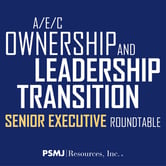While prospective owners inside an architecture or engineering firm will have better knowledge of its operations and value than someone outside, any potential buyer should ask the same questions that an outside buyer would ask.
-
Does the company have a track record of success?
-
Is there a good possibility to increase profits? (if the practice is already making 20%, the probability of increasing profit dramatically is low; if only 5% is being earned, the probability is high.)
The market
-
Is its chosen segment of the market expanding or contracting?
-
Is the market segment easy to enter for new firms or firms from other geographical areas?
-
What is the economic outlook for the firm’s services during the next five to ten years?
Financial status
-
What is the asset value of the company if it were
liquidated today?
-
Is the firm financially strong enough to suffer a few
economic reverses without a financial crisis?
-
What is the earnings record for the past five years?
-
Are previous earnings levels likely to continue?
-
Can any trend in earnings be detected, either up or down?
-
What percentage of the fees has been spent on business development?
-
Have excessive amounts been spent or has very little been spent in an effort to increase earnings for a short period?
-
How much money is tied up in accounts receivable and how old are the accounts?
-
Is work-in-process realistic? At cost or billing rates?
-
What is the deferred tax liability?
-
Is goodwill shown on the balance sheet?
-
If so, how much and what proportion is it of the price asked for the shares?
-
Does the practice have any current or long-term financial obligation to any person or company? If so, for how much and for how long?
-
Does the firm have audited or un-audited financial statements?
-
Have salary increases been promised that will erase a significant portion of the profit?
Ownership
-
What is the current distribution of stock?
-
What percent of shares are offered for sale?
-
What is the history of previous offers for sale, and sales?
-
Is voting or non-voting stock being offered?
-
Who has “control” of the company and will this change in the near future?
Staff
-
Will the key staff stay or leave the firm?
-
Have there been any recent terminations of key staff? Why?
-
Will the existing majority owner stay after the sale? If so, how long?
-
Is the second level of management and technical staff experienced?
-
Has there been a high turnover of staff?
-
What is the average length of service for key staff?
Legal issues
-
How many lawsuits have been filed against the company?
-
How many judgments?
-
How many lawsuits are still pending?
Compared with Other Firms
-
How does the practice compare in size and service capability to the acknowledged leaders in the market?
-
What is the ratio of professional to non-professional staff, and does this compare favorably with other similar firms?
-
How do salary levels compare with other firms in the same geographic area?
Planning for a successful ownership transition is one of the biggest long-term challenges facing A/E firm leaders today. The next challenge is how to take such a complex and multi-dimensional process, and translate it into clear steps that you can actually implement.
 A/E/C firm owners who fail to plan properly on ownership transition are leaving the firm exposed to the potential for undesirable outcomes - including significant loss of firm value, brand equity deterioration, and loss of market position. Instead of being another ordinary seminar teaching you how to develop a plan, PSMJ's A/E/C Ownership & Leadership Transition Roundtable takes you through virtually every transition planning obstacle you will encounter (from affordability to leadership development and more) and how to overcome it.
A/E/C firm owners who fail to plan properly on ownership transition are leaving the firm exposed to the potential for undesirable outcomes - including significant loss of firm value, brand equity deterioration, and loss of market position. Instead of being another ordinary seminar teaching you how to develop a plan, PSMJ's A/E/C Ownership & Leadership Transition Roundtable takes you through virtually every transition planning obstacle you will encounter (from affordability to leadership development and more) and how to overcome it.
You also might be interested in these ownership transition related blog posts:
Changing Expectations of Firm Ownership
How to Get Millennials to Buy In to Firm Ownership
What Potential Firm Owners Need to Know




